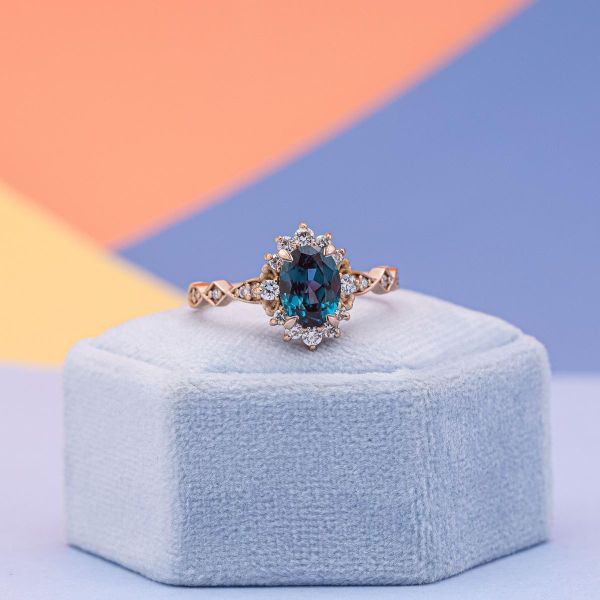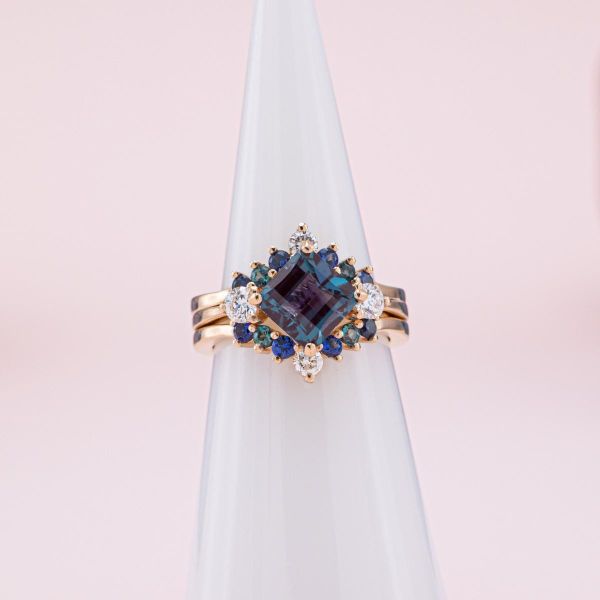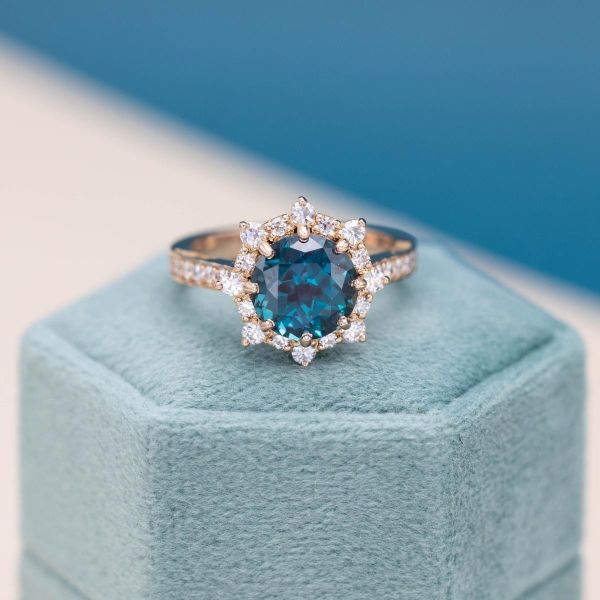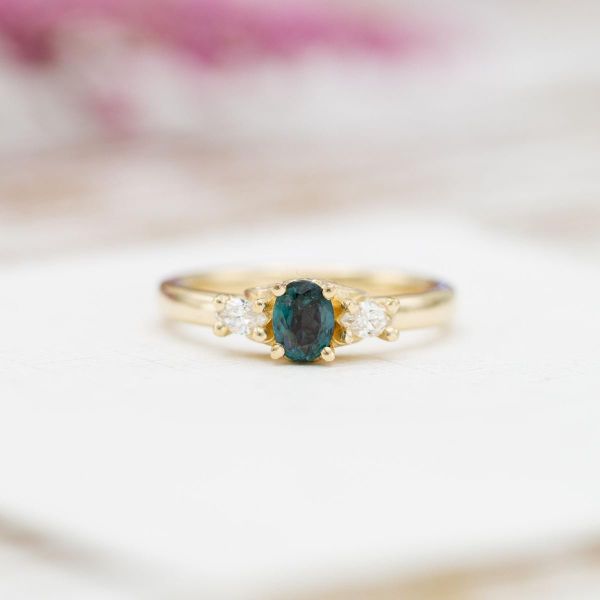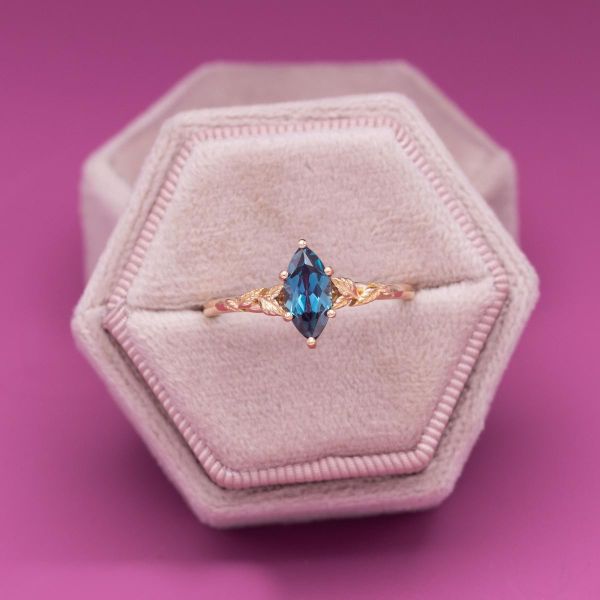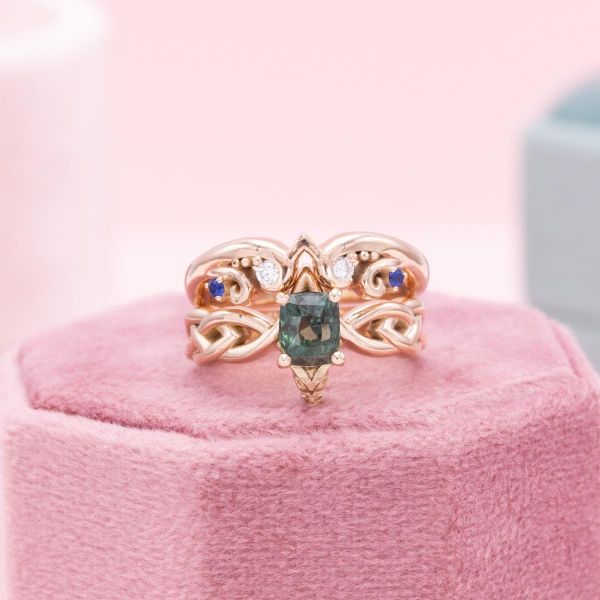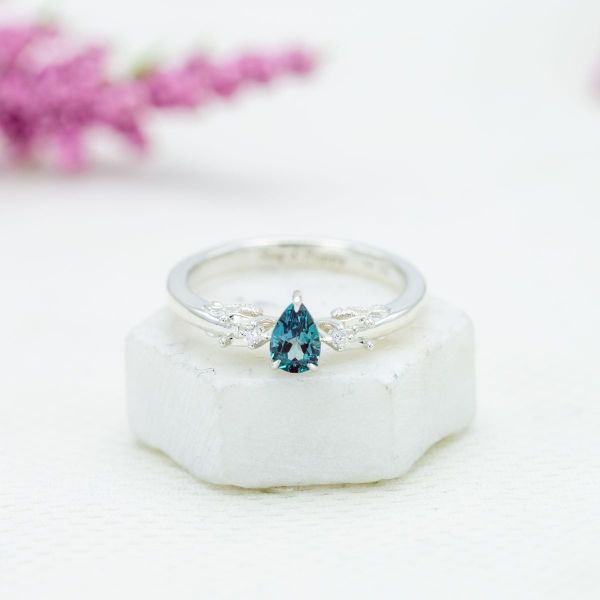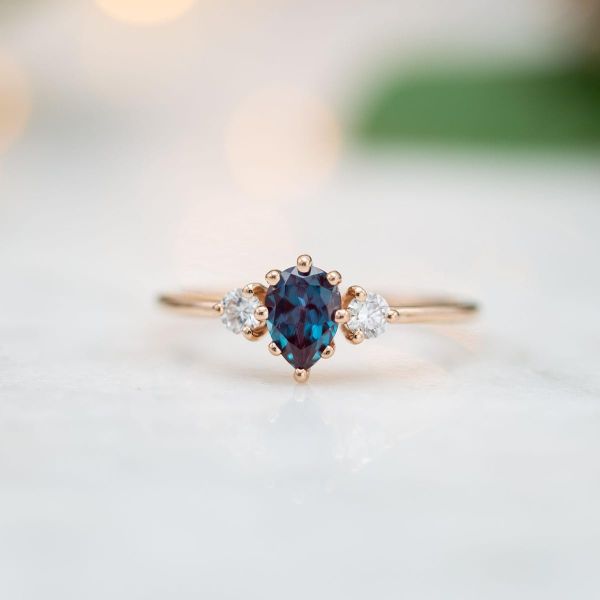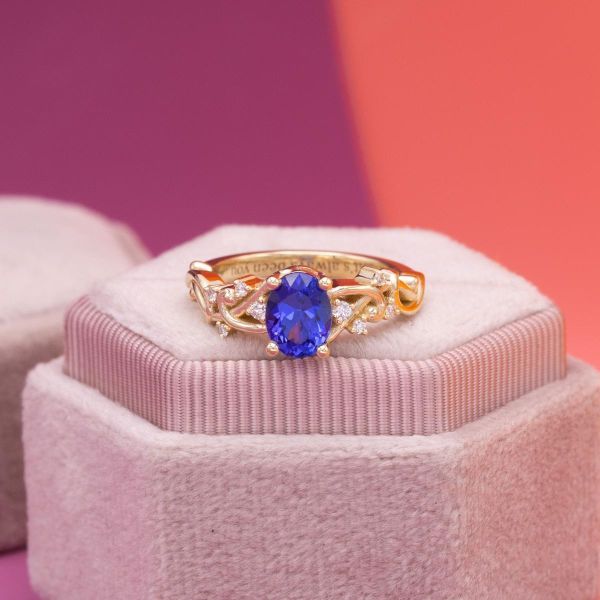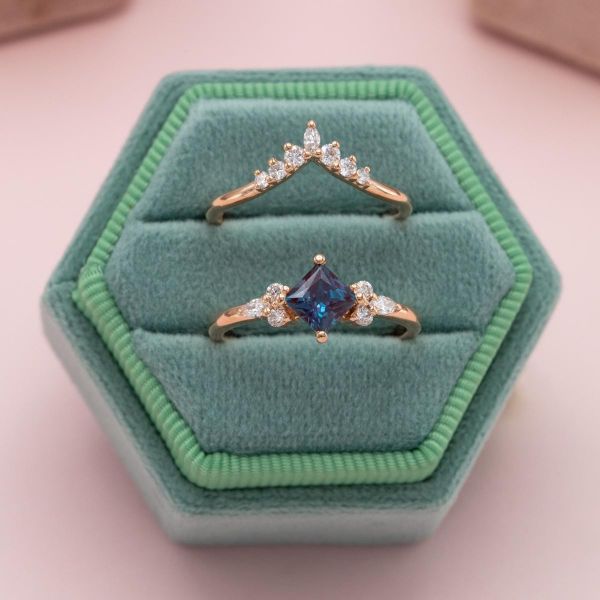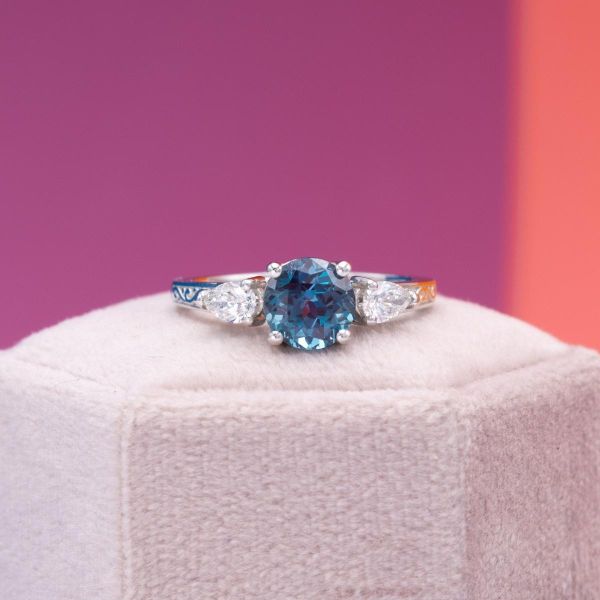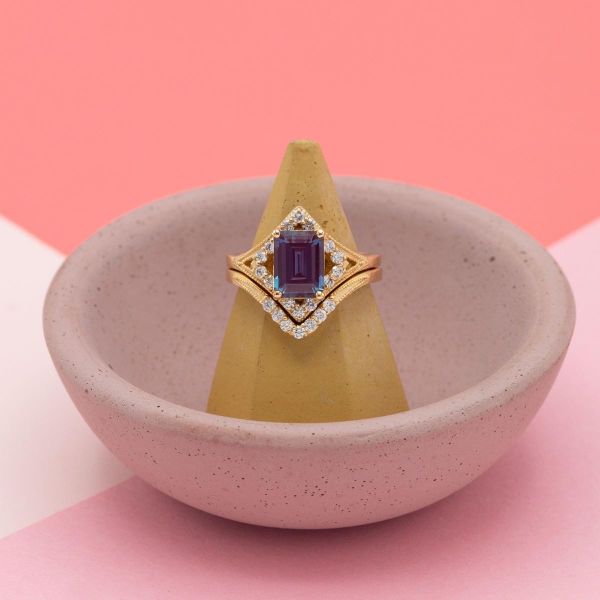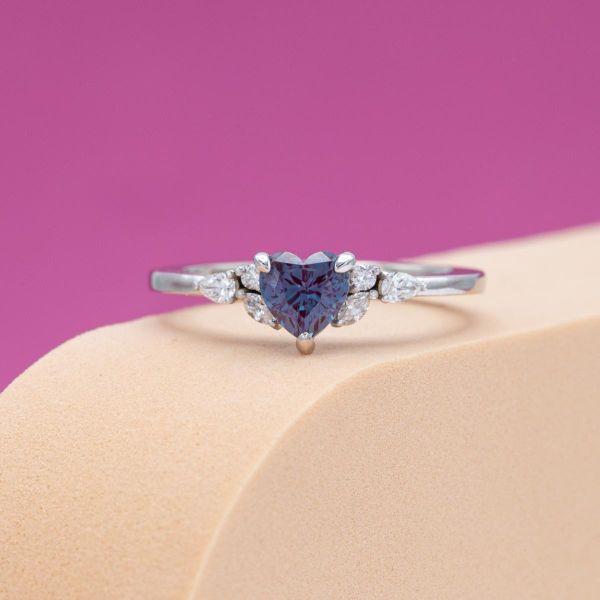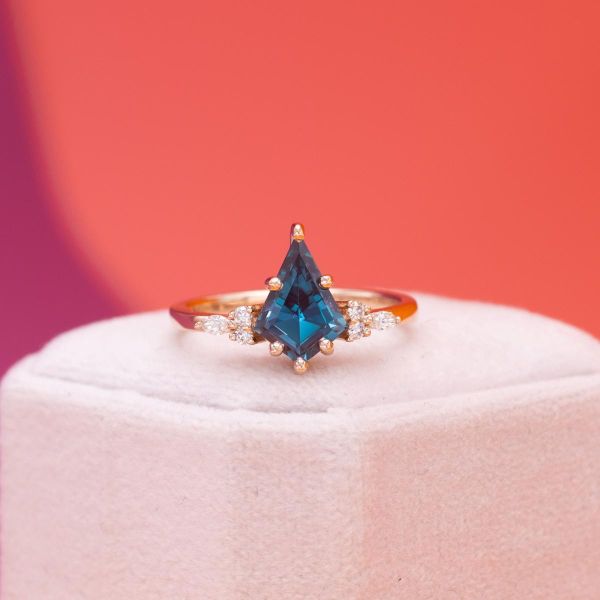Gemstone Knowledge
Exploring alexandrite's color
A thorough look at alexandrite’s shade-shifting properties and other color factors.
Emerald by day, ruby by night
Alexandrite is a naturally rare stone famous for its chameleon-like qualities, appearing to switch from cooler to warmer tones right before your eyes! But not every alexandrite will feature a significant color change, and this stone’s hues can vary, ranging from the classic green and red to blue, purple, pink, brown, and even vague hints of orange and yellow. With such an impressive palette, how can you know which colors you’re getting when shopping for your own alexandrite? Let’s brush up on the many faces of alexandrite and what to expect from this color-shifting stone!
Alexandrite’s shifting colors
Many couples fall in love with the color shifting properties of alexandrite, and it’s almost like you get two stones in one! Some call alexandrite “an emerald by day, ruby by night” because it appears to change color under different lighting. Daylight or fluorescent lighting produces greenish hues, whereas incandescent and dim lighting reveal shades of purplish-red.
So why exactly does this happen? The phenomenon is so complicated that the scientific journal Nature published research on it in 2020. Seriously—the world's top gem scientists are still getting to the bottom of it! We'll do our best at giving you a summary.
Does alexandrite actually change colors? Experts believe it’s nothing so magical, but it is a pretty neat science trick! Instead, the way our eyes and brains perceive alexandrite’s color changes when the lighting in our environment changes. Alexandrite contains chromium, which causes the stone to exhibit both green and red hues at any given time based on the visible spectrum of color. Pretty neat, huh?
Natural and fluorescent lighting have higher levels of blue and green light, and our eyes are already more sensitive to green light. In these conditions, more green light is reflected by the stone to our eyes as light moves through it, so we see more of alexandrite’s blue and green hues as a result. Dimmer lighting—like what’s produced by a candle or lamp—has a higher balance of red light, helping us see beyond the green spectrum we’re accustomed to and notice the red light reflecting through alexandrite back to us, which changes its visible color to red.
The green to red transition is the most well known, but you can find a wide variety of color combinations across different alexandrite stones, including blue and blue-green in bright lighting and purple, brown, or even pinkish shades in dim lighting.
You can also find opaque alexandrite stones that exhibit a similar color change! They’re known as cat’s eye alexandrite, and their name refers to the striking, bright line that seems to run through the center of the stone like the pupil in a cat’s eye. Opaque versions of alexandrite are rare, so be ready to pay a pretty penny for these unique stones if that’s more your style.
It’s worth noting that not all alexandrites change color equally, and the color transition is more of a percentage than a guarantee. In fact, some stones exhibit nearly 100% color shift while others only display 5%. A high-quality color change is typically anywhere from 85% to 95%, meaning that some facets still won’t display a total color shift. The important thing to remember is that you should examine each alexandrite individually in varied lighting to understand how much of this color change you can expect from each stone.
Pleochroism
In addition to its shifting colors, alexandrite is “pleochroic”, which means that individual facets will appear to have different colors when seen from different angles... We know what you’re probably thinking: isn’t that the same thing as the color change described above? Not quite!
Pleochroism is more closely related to direction, not lighting. Light enters the alexandrite’s facets at different angles and travels through the stone, bouncing around before exiting again. The result is an understated color shifting effect that changes the hue of some facets as you move the stone back and forth. Because the varied angles of an alexandrite’s facets are what create the pleochroic color display, it doesn’t occur over the entire stone as you move it. Instead, a few facets may take on subtle hints of orange, blue, or purple-red, but it’s a soft, watercolor effect when compared to the color transition that occurs under different light sources.
Lab made alexandrite
It’s worth mentioning that, while these color transitions and characteristics may be a little less uniform in natural stones, lab made alexandrites have a standardized color palette and noticeable color change. Because they’re made in a lab under controlled conditions, these alexandrites often carry the same or similar qualities, making them a reliable choice as engagement stones.
Lab alexandrite doesn’t have as much of that green color some people love, but instead it has a soothing blue hue that is stealing the hearts of more and more engaged couples nowadays. Some stones even carry a unique teal coloration, and lab alexandrite often transitions from these cooler hues to rich shades of purple or red. So while there may still be some color variation among lab alexandrites, their color transitions are more controlled. Many find that they look just as stunning as natural stones!
Hue, tone, and saturation
While alexandrite’s color transition is important, hue, tone, and saturation also play a role in each stone’s overall appeal. But aren’t these terms all the same thing?! Now now, is anything ever that simple when it comes to gemstones? In the gemological world, these terms actually all describe different properties of a stone’s color. But don’t worry, we’ll briefly break down each one for you so you can shop for alexandrite like a pro! If you’re looking for a bit more info on hue, tone, and saturation, check out our article on gem color.
For starters, hue is the basic color of the stone and essentially describes where it falls on the color wheel. We already discussed how classic alexandrite is green during the day and red at night, but this stone comes in so many hues it’s almost dizzying! Its hue can range from emerald green to peacock blue during the day and ruby red or even amethyst purple shades in dimmer lighting, and–as we already discussed–lab alexandrites come in equally exquisite hues. So as you can see, saying you want an alexandrite isn’t as easy as just picking one out. But don’t worry, at CustomMade we help couples hand-choose every center stone!
Instead of describing the actual color, tone is more of a white to black scale that describes how lively a stone appears. Think of your typical onyx compared to an aquamarine. Onyx often appears almost opaque, where aquamarine allows you to see all of the facets within the stone. For these stones, onyx tends to have a closed tone, where aquamarine is open.
In alexandrite, tone also relates to the intensity of its color change. Darker tones in the 75%-85% range are ideal for high-quality color change, but most stones sit in the 40%-60% range and feature light green to pink tones. This gives you an idea of how rare complete color changes in alexandrite really are!
Finally, saturation is the depth and richness of a stone’s color. Think of making colored frosting and mixing one drop of food coloring into the gooey goodness (light saturation) versus the whole bottle of food coloring (strong saturation). It’s the same color, just different amounts. In alexandrites, saturation is helpful for getting those deeper colors like red-purple or emerald green. Moderately strong to strong saturation will result in richer colors for your alexandrite, but lighter saturation may result in lovely lighter colors like spring green, amethyst, or those pinkish tones we mentioned earlier.
Color alternatives
Lab alexandrite is an excellent alternative to pricey mined varieties, but what if you’re not 100% sold on either stone’s color-shifting appeal? Maybe you’ve fallen in love with one of the many blues, purples, or reds that alexandrite can produce. If so, here are some top alternatives for alexandrite by color.
Blue: Sapphire
If you’re seeking a sturdy blue stone, sapphire is a great alternative to alexandrite. It ranks at a 9 on the Mohs scale, making it slightly more durable than alexandrite for excellent daily wear. Although we tend to think of the classic, royal blue stone when we imagine a sapphire, you can actually find it in a variety of hues including green, purple, pink, and yellow. In the blue family, colors range from light blue to so-dark-it’s-almost-black depending on each stone’s saturation and tone, and the more vibrant the blue, the higher the price. Classy, elegant, and a favorite of royal fashion icon Kate Middleton, sapphire is a solid choice for anyone looking for a blue engagement stone.
Purple: Tanzanite
If you’re mesmerized by the lively purples of alexandrite, you may want to take a closer look at tanzanite. On the Mohs scale, tanzanite is about a 6 to 7, so it can still withstand daily wear and tear with relative ease, but it does lean a bit more on the delicate side than alexandrite. Tanzanite's color ranges from a vibrant blue to a vivid violet, and tanzanite can also exhibit both color change and pleochroism! It can appear sapphire blue during the day and violet or amethyst at night, with pleochroic displays of blue, red-violet, and even yellow-green. Like alexandrite, tanzanite can even feature the cat’s eye effect in opaque gems. These versions are ultra rare–and ultra pricey–but their violet-blue hues are a perfect uncommon stone for a one-of-a-kind engagement ring!
Red: Garnet
Maybe you’re drawn to the ruby red hue of alexandrite in dim lighting. If this is the case, garnet may be your ideal alternative. Depending on the color, garnet ranges from 6.5 to 7.5 on the Mohs scale, so while it’s still a fine choice for an engagement ring, you’ll have to be a bit more cautious than you would with alexandrite. Garnets actually come in a variety of colors, but the dark, pinkish red tones–like a pomegranate seed–as well as ruby hues and purplish reds are the closest to the colors you’d find in alexandrite. Some garnets even have color changing properties similar to alexandrite, but keep in mind these stones come at a higher cost. One garnet discovered in Madagascar featured a rare blue-green to purple transition and sold for an eye-popping $1.5 million as a result!
Conclusion
So are you all in on alexandrite? It’s not everyday that you find a color shifting stone for your engagement ring, and the huge variety of colors, variations, and more are what make alexandrite so special. Plus, the “marrying” of two colors in one stone is a lovely symbol for marriage itself as you and your partner come together as one for a lifetime of happiness! If alexandrite is your pick, then reach out to our team today to get started on your custom engagement ring.
About CustomMade
CustomMade designs and creates one-of-a-kind, custom engagement rings and fine jewelry. Each piece we create is inspired by you, designed for you, and made just for you.
